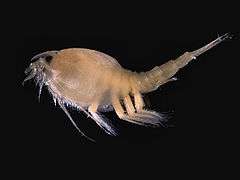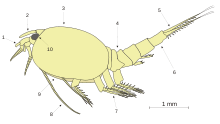Leptostraca
Leptostraca (from the Greek words for thin and shell)[3] is an order of small, marine crustaceans. Its members, including the well-studied Nebalia, occur throughout the world's oceans and are usually considered to be filter-feeders.[4] It is the only extant order in the subclass Phyllocarida. They are believed to represent the most primitive members of their class, the Malacostraca, and first appear in the fossil record during the Cambrian period.[5]
| Leptostraca | |
|---|---|
 | |
| Nebalia bipes | |
| Scientific classification | |
| Kingdom: | |
| Phylum: | |
| Subphylum: | |
| Class: | |
| Subclass: | |
| Order: | Leptostraca |
| Families [2] | |
| |
Description

Leptostracans are usually small, typically 5 to 15 millimetres (0.2 to 0.6 in) long,[6] crustaceans distinguished from all other members of their class in having seven abdominal segments, instead of six. Their head has stalked compound eyes, two pairs of antennae (one biramous, one uniramous), and a pair of mandibles but no maxillipeds.[4] The carapace is large and comprises two valves which cover the head and the thorax, including most of the thoracic appendages, and serves as a brood pouch for the developing embryos. The first six abdominal segments bear pleopods, while the seventh bears a pair of caudal furcae, which may be homologous to uropods of other crustaceans.[7]
Leptostracans have gills on their thoracic limbs, but also breathe through a respiratory membrane on the inside of the carapace. The eggs hatch as a postlarval, or "manca" stage, which lacks a fully developed carapace, but otherwise resembles the adult.[5]
Classification
It is now accepted that leptostracans belong to the Malacostraca,[8] and the sister crown group to Leptostraca is Eumalacostraca.[9]
The Order Leptostraca is divided into three families, with ten genera containing a total of around 40 validly described extant species:[10]
| Species | Authority | Date | Family | Distribution |
|---|---|---|---|---|
| Nebaliopsis typica | Sars | 1887 | Nebaliopsididae | Southern Hemisphere [2] |
| Pseudonebaliopsis atlantica | Petryachov | 1996 | Nebaliopsididae | North Atlantic [11] |
| Nebalia antarctica | Dahl | 1990 | Nebaliidae | Antarctica [2] |
| Nebalia bipes | Fabricius | 1780 | Nebaliidae | Arctic and sub-Arctic [2] |
| Nebalia borealis | Dahl | 1985 | Nebaliidae | north-east Atlantic Ocean [2] |
| Nebalia brucei | Olesen | 1999 | Nebaliidae | Tanzania [2] |
| Nebalia cannoni | Dahl | 1990 | Nebaliidae | South Georgia [2] |
| Nebalia capensis | Barnard | 1914 | Nebaliidae | South Africa [2] |
| Nebalia clausi | Dahl | 1985 | Nebaliidae | Italy [2] |
| Nebalia dahli | Kazmi & Tirmizi | 1989 | Nebaliidae | Pakistan [2] |
| Nebalia daytoni | Vetter | 1996 | Nebaliidae | California [2] |
| Nebalia falklandensis | Dahl | 1990 | Nebaliidae | Falkland Islands |
| Nebalia geoffroyi | Milne-Edwards | 1828 | Nebaliidae | north-east Atlantic Ocean [12] |
| Nebalia gerkenae | Haney & Martin | 2000 | Nebaliidae | California [2] |
| Nebalia herbstii | Leach | 1814 | Nebaliidae | north-east Atlantic Ocean [2] |
| Nebalia hessleri | Martin et al. | 1996 | Nebaliidae | California [2] |
| Nebalia ilheoensis | Kensley | 1976 | Nebaliidae | south-western Africa [2] |
| Nebalia kensleyi | Haney & Martin | 2005 | Nebaliidae | California [13] |
| Nebalia kocatasi | Kocak, Moreira & Katagan | 2007 | Nebaliidae | Mediterranean Sea [14] |
| Nebalia koreana | Song, Moreira & Min | 2012 | Nebaliidae | South Korea [15] |
| Nebalia lagartensis | Escobar & Villalobos-Hiriart | 1995 | Nebaliidae | Mexico [2] |
| Nebalia longicornis | Thomson | 1879 | Nebaliidae | South Pacific, South Africa, Caribbean Sea [2] |
| Nebalia marerubi | Wägele | 1983 | Nebaliidae | Red Sea [2] |
| Nebalia patagonica | Dahl | 1990 | Nebaliidae | Magellan region [2] |
| Nebalia schizophthalma | Haney, Hessler & Martin | 2001 | Nebaliidae | western Atlantic Ocean [16] |
| Nebalia strausi | Risso | 1826 | Nebaliidae | north-east Atlantic Ocean, Mediterranean Sea [2] |
| Nebalia troncosoi | Moreira, Cacabelos & Dominguez | 2003 | Nebaliidae | Spain [17] |
| Nebaliella antarctica | Thiele | 1904 | Nebaliidae | Kerguelen, New Zealand [2] |
| Nebaliella brevicarinata | Kikuchi & Gamô | 1992 | Nebaliidae | Antarctica [2] |
| Nebaliella caboti | Clark | 1932 | Nebaliidae | Cabot Strait, New Jersey [2] |
| Nebaliella declivatas | Walker-Smith | 1998 | Nebaliidae | Australia [2] |
| Nebaliella extrema | Thiele | 1905 | Nebaliidae | Antarctica [2] |
| Dahlella caldariensis | Hessler | 1984 | Nebaliidae | East Pacific Rise [2] |
| Sarsinebalia cristobi | Moreira, Gestoso & Troncoso | 2003 | Nebaliidae | north-east Atlantic Ocean [18] |
| Sarsinebalia typhlops | (Sars) | 1870 | Nebaliidae | North Atlantic, Australia [2] |
| Sarsinebalia urgorrii | Moreira, Gestoso & Troncoso | 2003 | Nebaliidae | north-east Atlantic Ocean [18] |
| Speonebalia cannoni | Bowman, Yager & Iliffe | 1985 | Nebaliidae | Turks and Caicos Islands [2] |
| Levinebalia fortunata | (Wakabara) | 1976 | Paranebaliidae | New Zealand [2] |
| Levinebalia maria | Walker-Smith | 2000 | Paranebaliidae | Australia [2] |
| Paranebalia belizensis | Modlin | 1991 | Paranebaliidae | Belize [2] |
| Paranebalia longipes | (Willemöes-Suhm) | 1875 | Paranebaliidae | Atlantic, Pacific and Indian Oceans [2] |
| Saronebalia guanensis | Haney & Martin | 2004 | Paranebaliidae | British Virgin Islands [19] |
References
- "Leptostraca". Integrated Taxonomic Information System. Retrieved October 28, 2010.
- Genefor K. Walker-Smith; Gary C. B. Poore (2001). "A phylogeny of the Leptostraca (Crustacea) with keys to families and genera" (PDF). Memoirs of Museum Victoria. 58 (2): 383–410. doi:10.24199/j.mmv.2001.58.21.
- "Leptostraca". Online Medical Dictionary. March 1, 1998.
- J. K. Lowry (October 2, 1999). "Leptostraca". Crustacea, the Higher Taxa: Description, Identification, and Information Retrieval. Australian Museum. Archived from the original on September 23, 2017. Retrieved August 8, 2007.
- Robert D. Barnes (1982). Invertebrate Zoology. Philadelphia, PA: Holt-Saunders International. pp. 708–709. ISBN 978-0-03-056747-6.
- Estela C. Lopretto (July 30, 2003). "Phyllocarida". Answers.com.
- F. Knopf; S. Koenemann; F. R. Schram & C. Wolff (2006). "The urosome of the Pan- and Peracarida" (PDF). Contributions to Zoology. 75 (1/2): 1–21. doi:10.1163/18759866-0750102001.
- J. W. Martin; G. E. Davis (2001). An Updated Classification of the Recent Crustacea (PDF). Natural History Museum of Los Angeles County. pp. 132 pp.
- "Malacostraca". Tree of Life Web Project. January 1, 2002.
- Todd Haney (2004). "Classification". Natural History Museum of Los Angeles County. Retrieved August 8, 2007.
- V. V. Petryashov (1996). "Pseudonebaliopsis atlantica gen. n., sp. n., is a new genus and a new species of Leptostraca (Crustacea, Malacostraca) from the central part of the North Atlantic". Zoologichesky Zhurnal (in Russian). 75 (12): 1892–1896.
- Todd Haney. "Synonymy". Los Angeles PEET Project on Leptostraca. Natural History Museum of Los Angeles County. Archived from the original on September 6, 2008. Retrieved February 28, 2009.
- Todd A. Haney & Joel W. Martin (2005). Boyko, Christopher B. (ed.). "Nebalia kensleyi, a new species of leptostracan (Crustacea: Phyllocarida) from Tomales Bay, California" (PDF). Proceedings of the Biological Society of Washington. 118 (l): 3–20. doi:10.2988/0006-324X(2005)118[3:NKANSO]2.0.CO;2.
- Juan Moreira; Cengiz Kocak; Tuncer Katagan (2007). "Nebalia kocatasi sp. nov., a new species of leptostracan (Crustacea: Phyllocarida) from Izmir Bay (Aegean Sea, eastern Mediterranean)". Journal of the Marine Biological Association of the United Kingdom. 87 (5): 1247–1254. doi:10.1017/S0025315407057487.
- Ji-Hun Song; Juan Moreira; Gi-Sik Min (2012). "A New Species of Leptostraca, Nebalia koreana (Malacostraca: Phyllocarida), from South Korea". Journal of Crustacean Biology. 32 (4): 641–653. doi:10.1163/193724012X638482.
- Todd A. Haney; Robert R. Hessler; Joel W. Martin (2001). "Nebalia schizophthalma, a new species of Leptostracan (Malacostraca) from deep waters off the east coast of the United States" (PDF). Journal of Crustacean Biology. 21 (1): 192–201. doi:10.1651/0278-0372(2001)021[0192:NSANSO]2.0.CO;2.
- Juan Moreira; Eva Cacabelos; Marta Domínguez (2003). "Nebalia troncosoi sp. nov., a new species of leptostracan (Crustacea: Phyllocarida: Leptostraca) from Galicia, Iberian Peninsula (north-east Atlantic)". Journal of the Marine Biological Association of the United Kingdom. 83 (2): 341–350. doi:10.1017/S0025315403007173h.
- J. Moreira; L. Gestoso; J. S. Troncoso (2003). "Two new species of Sarsinebalia (Crustacea, Leptostraca) from the Northeast Atlantic, with comments on the genus". Sarsia: North Atlantic Marine Science. 88 (3): 189–209. doi:10.1080/00364820310001390.
- Todd Haney; Joel W. Martin (2004). "A new genus and species of leptostracan (Crustacea: Malacostraca: Phyllocarida) from Guana Island, British Virgin Islands, and a review of leptostracan genera" (PDF). Journal of Natural History. 38 (4): 447–469. doi:10.1080/0022293021000033210.
External links

